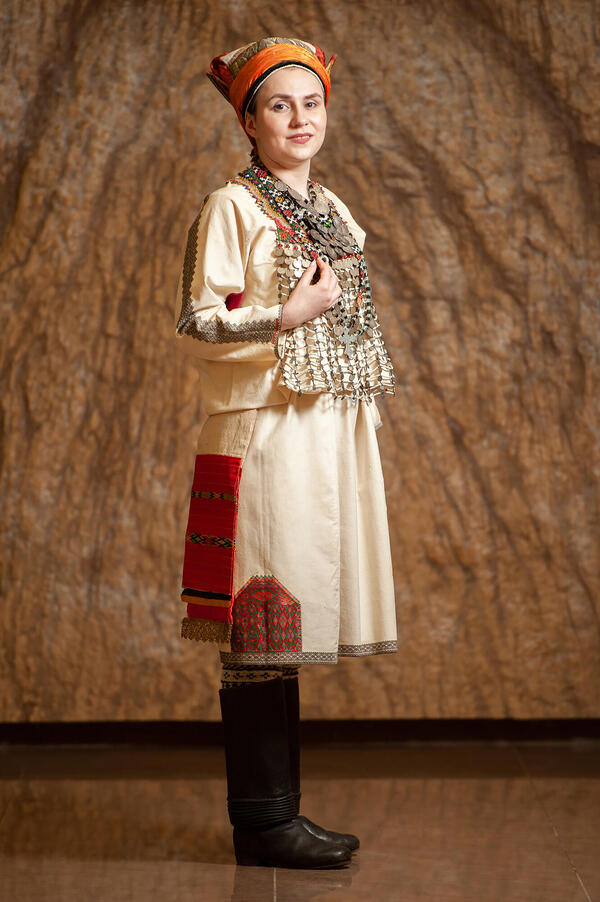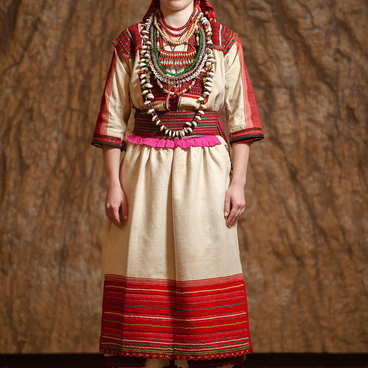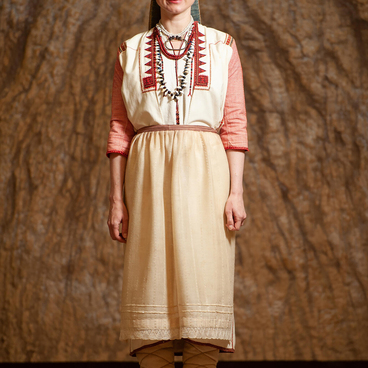The traditional clothing of the Moksha of the southwestern group is known for its rich pectoral ornaments and fine, elaborate embroidery. A local feature of the Moksha costume of this group the monolithic silhouette and opulent forms produced by numerous draperies. A white shirt was worn with a large overlap; soft pleats rounded the body lines, emphasizing a woman’s stately figure.
The core piece of the festive costume is an ozha ki shcham, a shirt with fine openwork embroidery along the sleeves and at the bottom of the hem as well as large motifs of embroidered elements on the sides, made with multicolored threads in the “brick” technique. The whiteness of the canvas is accentuated by fine embroidery in monochrome and bright contrasting colors.
Patterned beaded adornments serve as an ornate and refined complement to the costume. The contrasts of white and black, purple and green, blue and orange in combination with the shine of silver coins, with shimmering glass of bugles and beads create the illusion of precious materials. The set of ornaments has distinctive features. It includes a trapezoidal shaped syulgam decorated with rows of coins. Other elements of pectoral decor were clustered around the syulgam: the round collar krgan pirf, beaded band, and beads. Of special interest is the krgan pirif ornament. Tied in the form of a rounded shoulder piece, the krgan pirf in the front ends with an elastic net bib made of strings of beads on horsehair, which are connected with wire links. The beaded band, on which the cross was suspended, was obligatory in the set of ornaments.
The waist part of the ensemble was decorated with pendants — karx tsekt, the set of which consisted of several parts. As a rule, they were paired and placed on one side, while the other side was balanced by towels. A special role was given to the side towels boka rutsyat, which were woven from red threads and decorated with rows of ribbons, braid, and lace.
An ancient female zlatnoy headdress is a cap made of canvas, lined with red silk; its front part was decorated with a wide quadrangle of goldwork monastic embroidery, and to the side wings square solid shields were sewn, covered with red calico and decorated with silk ribbons, velvet and braid. They wore a zlatnoy on the volosnik headpiece with a frame of straight plank on top of it.
The ensemble is completed by footwear: the kyamot pleated boots belonged to the category of expensive festive footwear.
The core piece of the festive costume is an ozha ki shcham, a shirt with fine openwork embroidery along the sleeves and at the bottom of the hem as well as large motifs of embroidered elements on the sides, made with multicolored threads in the “brick” technique. The whiteness of the canvas is accentuated by fine embroidery in monochrome and bright contrasting colors.
Patterned beaded adornments serve as an ornate and refined complement to the costume. The contrasts of white and black, purple and green, blue and orange in combination with the shine of silver coins, with shimmering glass of bugles and beads create the illusion of precious materials. The set of ornaments has distinctive features. It includes a trapezoidal shaped syulgam decorated with rows of coins. Other elements of pectoral decor were clustered around the syulgam: the round collar krgan pirf, beaded band, and beads. Of special interest is the krgan pirif ornament. Tied in the form of a rounded shoulder piece, the krgan pirf in the front ends with an elastic net bib made of strings of beads on horsehair, which are connected with wire links. The beaded band, on which the cross was suspended, was obligatory in the set of ornaments.
The waist part of the ensemble was decorated with pendants — karx tsekt, the set of which consisted of several parts. As a rule, they were paired and placed on one side, while the other side was balanced by towels. A special role was given to the side towels boka rutsyat, which were woven from red threads and decorated with rows of ribbons, braid, and lace.
An ancient female zlatnoy headdress is a cap made of canvas, lined with red silk; its front part was decorated with a wide quadrangle of goldwork monastic embroidery, and to the side wings square solid shields were sewn, covered with red calico and decorated with silk ribbons, velvet and braid. They wore a zlatnoy on the volosnik headpiece with a frame of straight plank on top of it.
The ensemble is completed by footwear: the kyamot pleated boots belonged to the category of expensive festive footwear.





